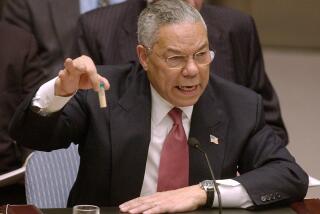A Room Where No One Sleeps
- Share via
As war with Iraq approaches, there is a group in the West Wing that will be indispensable to President Bush -- and it’s not Dick Cheney, Condoleezza Rice, Colin Powell, Donald Rumsfeld or his other senior advisors.
It’s the White House Situation Room staff.
The Situation Room is not just a room, although the mystique of the place evolves from the plush conference room, no larger than your living room, at the center of the complex. Bush is familiar with the facility just downstairs from the Oval Office: He met there daily with his advisors in the aftermath of 9/11.
If he starts a war with Iraq, Bush will convene the same group in the conference room to assess the course of the fighting. In war, however, the strength of the Situation Room is not meetings, it’s information.
And it’s the staff that provides that information.
Perishable information flows into the White House through several portals, but the bulk of the traffic funnels through the “Sit Room,” which, by the way, is never called the War Room -- that’s a Pentagon establishment.
Right now, duty officers are screening news reports, mining the Internet and reading diplomatic and intelligence reports from the State Department and the CIA for key developments that might influence the president’s decision on when to initiate a war.
Critical are reports of further Iraqi deception, the status of Iraqi military forces, support for U.S. plans -- especially in China, Europe and the Arab world -- and the readiness of U.S. and coalition military forces. Where’s that smoking gun? Oh, and what’s happening in North Korea?
The staff is on duty all day, every day, but the night watch gets the most action because of events in Asia and the Middle East, which seem to occur most often when Americans, including the president, are sleeping.
Fighting fatigue with bright lights and coffee, the night crew of three duty officers and a communications technician are at computer workstations looking for crucial developments that need immediate attention, regardless of the hour.
“If the phone rang at 2 a.m., it had to be either the president or the Situation Room,” recalled Tony Lake, President Clinton’s national security advisor. “Either way, my night was usually shot.”
In wartime, the alerting process will be triggered as soon as the results of battles are known. Preemptive actions by Iraq or terrorist incidents would also get the phone lines humming.
During the 1991 Gulf War, former Sit Room analyst Kevin O’Connell said the higher-ups limited access to super-secret war plans, excluding even the Sit Room duty officers.
“We were in deep trouble,” O’Connell told me, referring to the Sit Room’s inability to match reports from the field with planned objectives, until “Colin Powell understood our predicament and ‘accidentally’ left a map in the conference room that made us smarter.”
The major national security agencies send daily reports to the president and his staff, but even during war those reports reflect only the vision of each institution.
To satisfy the wider needs of the presidency, the Sit Room staff produces twice-daily summaries of international events. The summaries include every significant development, not just the topic du jour, and they are quick reads.
Some presidents and most national security advisors didn’t wait for summaries in past wars; they picked up the phone.
President Johnson called the Sit Room every night before he went to sleep, asking about the war in Vietnam -- then again in the morning.
George H.W. Bush called or visited the Sit Room every morning at 5 a.m. during the Gulf War to get an update rather than wait for the Pentagon briefing.
The Sit Room staff also organizes and places all presidential calls to other heads of state.
As Bush attempts to garner foreign support for war, he depends on the duty officers to make those connections. They arrange for an interpreter, take notes and write a “memorandum of conversation,” or MEMCON, for the record.
When I was director, we occasionally taped calls, but during the Iran-Contra scandal the Washington Post’s Bob Woodward caught wind of that practice. He ruined my day with his front-page story, complete with echoes of Watergate, about “secret” Sit Room taping systems.
The duty officers and analysts have responded successfully to thousands of “situations” and several wars since the Sit Room was created in 1961.
I once asked Henry Kissinger for his opinion of the Sit Room staff. Kissinger, who had earned a reputation as a hard taskmaster as national security advisor and secretary of State, said, “I took them for granted.”
He then leaned toward me and added: “From me, that is a very high compliment.”
More to Read
Sign up for Essential California
The most important California stories and recommendations in your inbox every morning.
You may occasionally receive promotional content from the Los Angeles Times.













